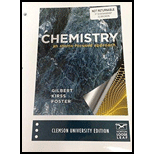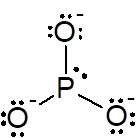
To find:
The molecular geometries of the given ions.
Answer to Problem 5.26QA
Solution:
The molecular geometries of the ions are (a) linear, (b) tetrahedral, (c) linear, and (d) trigonal pyramidal.
Explanation of Solution
a) SCN-:
i. The Lewis structure:
The total number of valence electrons in a molecule of SCN- is 16.
| Element | Valence electrons | ||
| Symbol | In one atom | Total | |
| S | 1 | 6 | 1 x 6 = 6 |
| C | 1 | 4 | 1 x 4 = 4 |
| N | 1 | 5 | 1 x 5 = 5 |
| Negative charge | 1 | ||
| Valence electrons in SCN- | 16 | ||
C is the central atom because C is least electronegative atom. The Lewis structure of SCN- is drawn by completing the octet of each element present in the molecule by adding lone pairs on it.

Formula to calculate steric number SN
ii. In the Lewis structure there is one S and one N atom attached to central C atom having no lone pair of electrons. So SN = 2. There is a -1 formal charge on S atom
iii. For SN = 2 and as the bond angle is 180o, molecular geometry is linear.
b) CH3PCl3+:
i. The Lewis structure:
The total number of valence electrons in a molecule of CH3PCl3+ is 32.
| Element | Valence electrons | ||
| Symbol | Number of atoms | In one atom | Total |
| C | 1 | 4 | 1 x 4 = 4 |
| H | 3 | 1 | 3 x 1 = 3 |
| P | 1 | 5 | 1 x 5 = 5 |
| Cl | 3 | 7 | 3 x 7 = 21 |
| Positive charge | -1 | ||
| Valence electrons in CH3PCl3+ | 32 | ||
P is the central atom. The Lewis structure of CH3PCl3+ is drawn by completing the octet of each element present in the molecule by adding lone pairs on it.

ii. In the Lewis structure there are three chlorine atoms and one CH3 group via C atom bonded to central P atom. So SN = 4. There is +1 formal charge on three O atoms. So SN = 4.
iii. For SN = 4, the molecular geometry is tetrahedral and bond angle is 109.5o.
c) ICl2-:
i. The Lewis structure:
The total number of valence electrons in a molecule of ICl2- is 22.
| Element | Valence electrons | ||
| Symbol | Number of atoms | In one atom | Total |
| I | 1 | 7 | 1 x 7 = 7 |
| Cl | 2 | 7 | 2 x 7 = 14 |
| Negative charge | 1 | ||
| Valence electrons in ICl2- | 22 | ||
I is the central atom because I is least electronegative atom. The Lewis structure of ICl2- is drawn by completing the octet of each element present in the molecule by adding lone pairs on it.

ii. In the Lewis structure there are two oxygen atoms bonded to central I atom. There are three lone pair on I atom with -1 formal charge. So SN = 5.
iii. For SN = 5, the electron geometry is trigonal bipyramidal. As all lone pairs are at equatorial position to minimize the repulsion the molecular geometry is linear.
d) PO33-:
i. The Lewis structure:
The total number of valence electrons in a molecule of PO33- is 26.
| Element | Valence electrons | ||
| Symbol | Number of atoms | In one atom | Total |
| P | 1 | 5 | 1 x 5 = 5 |
| O | 3 | 6 | 3 x 6 = 18 |
| Negative charge | 3 | ||
| Valence electrons in PO33- | 26 | ||
P is the central atom because P is least electronegative atom. The Lewis structure of PO33- is drawn by completing the octet of each element present in the molecule by adding lone pairs on it.

ii. In the Lewis structure there are three O atoms bonded to central P atom. There is one lone pair on P atom. So SN = 4.
iii. If SN = 4, the electron geometry is tetrahedral but as there is one lone pair on P atom and it is bonded to three O atoms the geometry is trigonal pyramidal.
Conclusion:
The molecular geometries of the ions are (a) linear, (b) tetrahedral, (c) linear, and (d) trigonal pyramidal.
Want to see more full solutions like this?
Chapter 5 Solutions
Chemistry: An Atoms-Focused Approach
- The following is a two groups (Regular tomato sauce & Salt Reduced Tomato Sauce) of data recorded by a team analysising salt content in tomato sauce using the MOHR titration method: Regular Tomato Sauce Salt Reduced Tomato Sauce 340.0 262.7 QUESTION: For both groups of data provide answers to the calculations attached in the imagearrow_forward7. Concentration and uncertainty in the estimate of concentration (class data) Class mean for sample (Regular) |[Cl-] (mmol/L) class mean Sn za/2 95% Confidence Interval (mmol/L) [Na+] (mg/100 mL) 95% Confidence Interval (mg/100 mL)arrow_forwardThe following is a two groups (Regular tomato sauce & Salt Reduced Tomato Sauce) of data recorded by a team analysising salt content in tomato sauce using the MOHR titration method: Regular Tomato Sauce Salt Reduced Tomato Sauce 223.4 148.7 353.7 278.2 334.6 268.7 305.6 234.4 340.0 262.7 304.3 283.2 244.7 143.6 QUESTION: For both groups of data calculate the answers attached in the image.arrow_forward
- Give reason(s) for six from the followings [using equations if possible] a. Addition of sodium carbonate to sulfanilic acid in the Methyl Orange preparation. b. What happened if the diazotization reaction gets warmed up by mistake. c. Addition of sodium nitrite in acidified solution in MO preparation through the diazotization d. Using sodium dithionite dihydrate in the second step for Luminol preparation. e. In nitroaniline preparation, addition of the acid mixture (nitric acid and sulfuric acid) to the product of step I. f. What is the main reason of the acylation step in nitroaniline preparation g. Heating under reflux. h. Fusion of an organic compound with sodium. HAND WRITTEN PLEASEarrow_forwardedict the major products of the following organic reaction: u A + ? CN Some important notes: • Draw the major product, or products, of the reaction in the drawing area below. • If there aren't any products, because no reaction will take place, check the box below the drawing area instead. Be sure to use wedge and dash bonds when necessary, for example to distinguish between major products that are enantiomers. Explanation Check Click and drag to start drawing a structure. Х © 2025 McGraw Hill LLC. All Rights Reserved. Te LMUNDARYarrow_forwardSketch the intermediates for A,B,C & D.arrow_forward
- Can the molecule on the right-hand side of this organic reaction be made in good yield from no more than two reactants, in one step, by moderately heating the reactants? O ? A . If your answer is yes, then draw the reactant or reactants in the drawing area below. You can draw the reactants in any arrangement you like. . If your answer is no, check the box under the drawing area instead. Explanation Check Click and drag to start drawing a structure. ㅇ 80 F5 F6 A 2025 McGraw Hill LLC. All Rights Reserved. Terms of Use | Privacy Cente FIGarrow_forwardIn methyl orange preparation, if the reaction started with 0.5 mole of sulfanilic acid to form the diazonium salt of this compound and then it converted to methyl orange [0.2 mole]. If the efficiency of the second step was 50%, Calculate: A. Equation(s) of Methyl Orange synthesis: Diazotization and coupling reactions. B. How much diazonium salt was formed in this reaction? C. The efficiency percentage of the diazotization reaction D. Efficiency percentage of the whole reaction.arrow_forwardHand written equations pleasearrow_forward
- Hand written equations pleasearrow_forward> each pair of substrates below, choose the one that will react faster in a substitution reaction, assuming that: 1. the rate of substitution doesn't depend on nucleophile concentration and 2. the products are a roughly 50/50 mixture of enantiomers. Substrate A Substrate B Faster Rate X Ś CI (Choose one) (Choose one) CI Br Explanation Check Br (Choose one) © 2025 McGraw Hill LLC. All Rights Farrow_forwardNMR spectrum of ethyl acetate has signals whose chemical shifts are indicated below. Which hydrogen or set of hydrogens corresponds to the signal at 4.1 ppm? Select the single best answer. The H O HỌC—C—0—CH, CH, 2 A ethyl acetate H NMR: 1.3 ppm, 2.0 ppm, 4.1 ppm Check OA B OC ch B C Save For Later Submit Ass © 2025 McGraw Hill LLC. All Rights Reserved. Terms of Use | Privacy Center |arrow_forward
 ChemistryChemistryISBN:9781305957404Author:Steven S. Zumdahl, Susan A. Zumdahl, Donald J. DeCostePublisher:Cengage Learning
ChemistryChemistryISBN:9781305957404Author:Steven S. Zumdahl, Susan A. Zumdahl, Donald J. DeCostePublisher:Cengage Learning ChemistryChemistryISBN:9781259911156Author:Raymond Chang Dr., Jason Overby ProfessorPublisher:McGraw-Hill Education
ChemistryChemistryISBN:9781259911156Author:Raymond Chang Dr., Jason Overby ProfessorPublisher:McGraw-Hill Education Principles of Instrumental AnalysisChemistryISBN:9781305577213Author:Douglas A. Skoog, F. James Holler, Stanley R. CrouchPublisher:Cengage Learning
Principles of Instrumental AnalysisChemistryISBN:9781305577213Author:Douglas A. Skoog, F. James Holler, Stanley R. CrouchPublisher:Cengage Learning Organic ChemistryChemistryISBN:9780078021558Author:Janice Gorzynski Smith Dr.Publisher:McGraw-Hill Education
Organic ChemistryChemistryISBN:9780078021558Author:Janice Gorzynski Smith Dr.Publisher:McGraw-Hill Education Chemistry: Principles and ReactionsChemistryISBN:9781305079373Author:William L. Masterton, Cecile N. HurleyPublisher:Cengage Learning
Chemistry: Principles and ReactionsChemistryISBN:9781305079373Author:William L. Masterton, Cecile N. HurleyPublisher:Cengage Learning Elementary Principles of Chemical Processes, Bind...ChemistryISBN:9781118431221Author:Richard M. Felder, Ronald W. Rousseau, Lisa G. BullardPublisher:WILEY
Elementary Principles of Chemical Processes, Bind...ChemistryISBN:9781118431221Author:Richard M. Felder, Ronald W. Rousseau, Lisa G. BullardPublisher:WILEY





